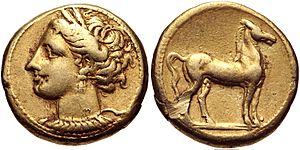Shekel facts for kids
A shekel (pronounced SHEK-el) was an ancient unit of weight. It was also used as a type of money, often made of silver. In ancient times, a shekel weighed about 11 grams (0.35 ounces). It first became a form of currency in ancient cities like Tyre and Carthage. Later, it was used in ancient Judea.
Contents
What Does "Shekel" Mean?
The word "shekel" comes from an old root word that means "to weigh." This is because the shekel was first a unit of weight, used to measure goods before coins were invented. The word "shekel" is found in very old languages like Akkadian and Sumerian. It was first written down around 2150 BC. In the Hebrew Bible, the word "shekel" first appears in the book of Genesis.
History of the Shekel
The earliest shekels were not coins. They were a way to measure weight, just like grams or ounces today. People used them for trading goods. The shekel was common among ancient groups in the Middle East, like the Moabites, Edomites, and Phoenicians.
Coins with official marks on them started to appear later. These marks showed that the coin had a certain weight and value. This made trading easier because people did not have to weigh the metal every time.
The value of a shekel changed over time and in different places. Its weight could be anywhere from 7 to 17 grams. In ancient Israel, during the time of the First Temple, a shekel weighed about 11.5 grams. Shekels were also used to pay workers. For example, ancient laws like the Code of Hammurabi mention wages paid in shekels.
Shekels in Ancient Israel
The Bible mentions a special "Shekel of the Sanctuary." This was a standard weight for shekels used for religious purposes in the Temple. For example, it was used to calculate the ingredients for holy oil.
During a census of the Israelites, every person counted had to pay a "half-shekel" to the Temple. This money helped with the Temple's upkeep and to buy animals for public offerings. This rule applied to Jews living both inside and outside the Land of Israel.
Archaeologists have found half-shekel coins from the 2nd century CE. These coins have "Half-Shekel" written on them in ancient Hebrew. They weighed about 6.87 grams of silver.
Shekels During Jewish Revolts
During the First Jewish–Roman War (66 to 70 AD), Jewish people issued their own shekel coins. They did this to show they were independent from Roman rule. These new coins replaced the Tyrian shekel, which had images of foreign gods.
Later, during the Bar Kokhba revolt (132 to 135 AD), more shekel coins were made for similar reasons.
Carthaginian Shekels
The ancient city of Carthage also had its own shekel coins. These were usually made of silver (about 7.2 grams) or gold (about 7.5 grams). Carthaginian shekels were first made in Sicily around the mid-4th century BC. They were often used to pay Carthage's armies.
Tyrian Shekels
Tyre, another ancient city, started making its own shekel coins around 300 BC. These "Tyrian shekels" were known for their pure silver. Because of this, they became the preferred way to pay the Temple tax in Jerusalem. Even though these coins had images of pagan gods, they were accepted for the Temple tax.
The story of Jesus expelling money changers from the Temple is related to these coins. The money changers helped people exchange their regular money for Tyrian shekels so they could pay the Temple tax. Some believe the "30 pieces of silver" paid to Judas Iscariot for betraying Jesus were Tyrian shekels.
The Shekel Today
Modern Israel
Today, the country of Israel uses a currency called the new shekel. It replaced an older currency called the Israeli pound in 1980. The symbol for the new shekel is ₪. It is often written as "NIS" or "ש״ח".
The new shekel is divided into 100 smaller units called agorot. Unlike the ancient shekel, the modern Israeli shekel is not based on the weight of any precious metal. It is a type of money called fiat currency, which means its value comes from the government that issues it.
See also
 In Spanish: Siclo para niños
In Spanish: Siclo para niños
- Ancient Mesopotamian units of measurement
- Gerah (ma'ah)
- Hanukkah gelt
- List of historical currencies
- Pidyon haben
- Prutah
- Tetradrachm
- Zuz



